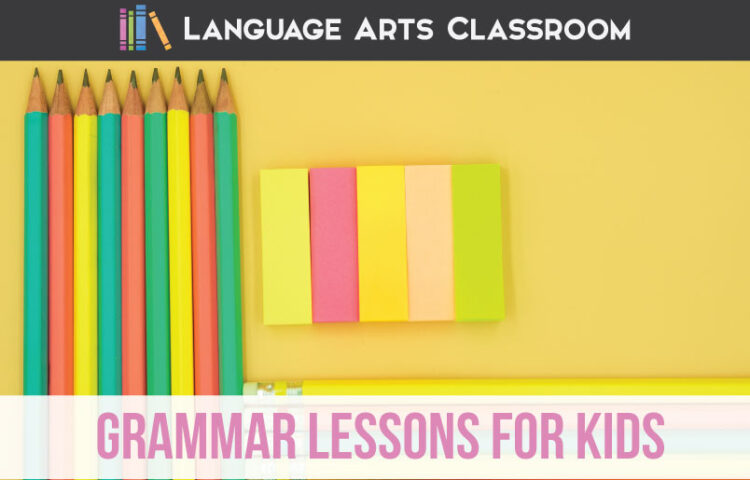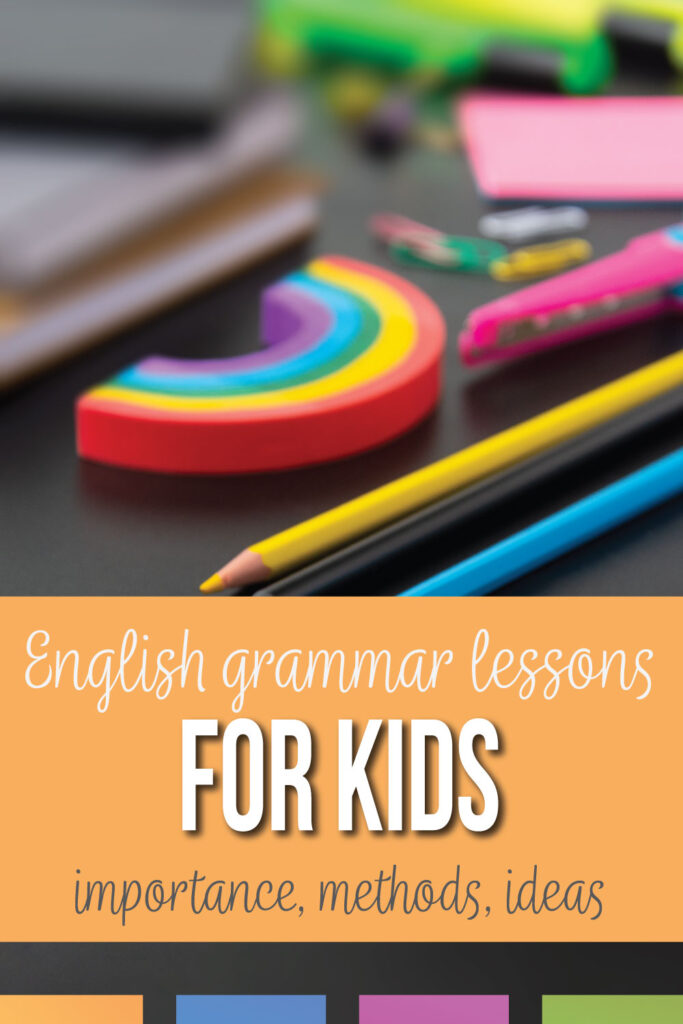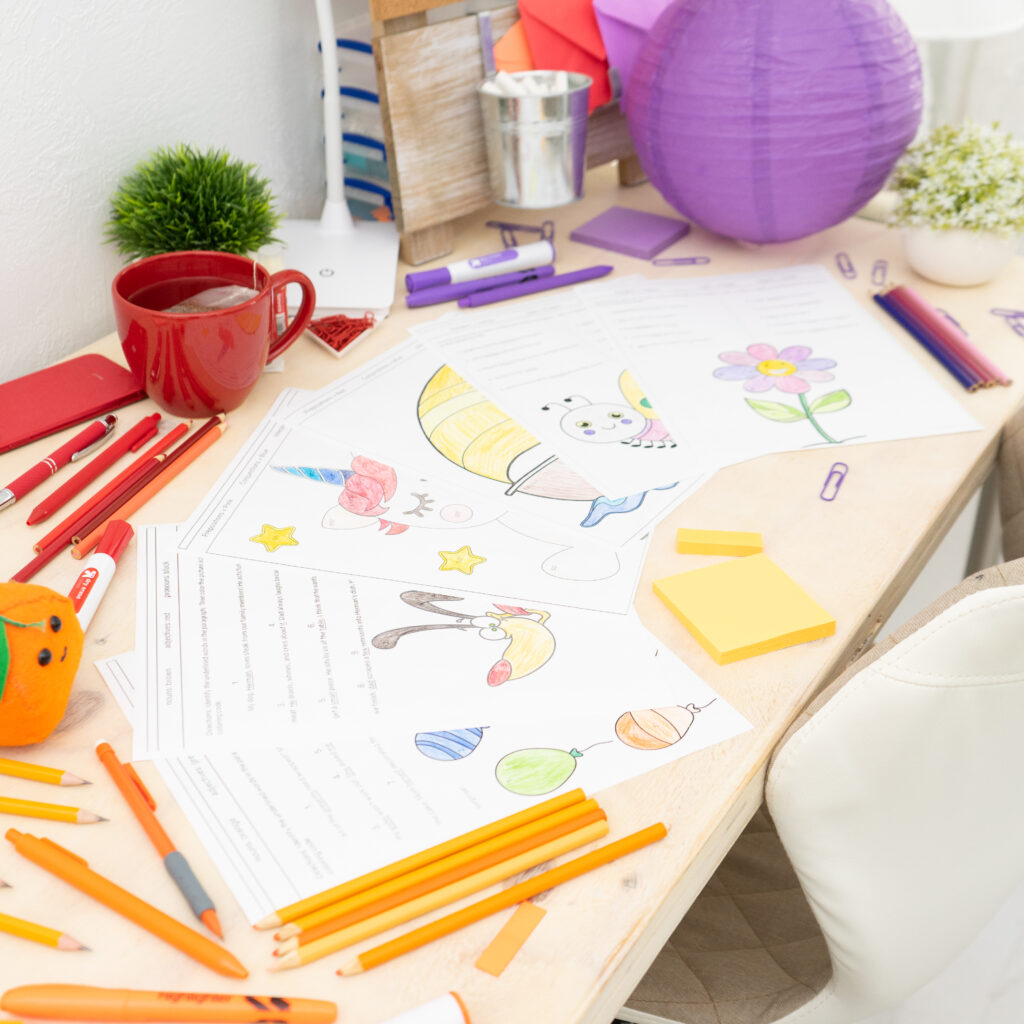English grammar lessons for kids—I cannot stress how important these foundational grammar lessons are.
I approach grammar lessons with students of all ages with my experience (naturally). I have taught grades 6-12, hold a master’s degree in English, and wrote a grammar book. Plus, I’ve raised three of my personal children past elementary school, experiencing three very different students studying grammar.
As a high school English teacher, I cannot emphasize enough the importance of English grammar lessons for kids. Students who arrive in my secondary classroom familiar with domain-specific language like the parts of speech and parts of a sentence are prepared to work on more complex language standards. Additionally, students who see grammar lessons as a natural part of language arts classes are not shocked with the level of work secondary English teachers expect. Finally, students who grasp grammar lessons naturally connect those concepts and ideas to writing, literature, and public speaking.
Basically, grammar lessons for young kids matter. Teachers ask me about the process for building grammar lessons, and in this post, I am specifically targeting grammar lessons for elementary kids. My experiences as a teacher, writer, and parent greatly influence my ideas below As a high school English teacher, however, I understand the value that foundational elementary grammar lessons provide.
Think through Grammar & Language
Grammar lessons for kids (of any age) should connect to parts of language arts and student’s lives. The approach we take with each grammar lesson will influence how our students interact with future discussions concerning language. (I often use both terms “grammar” and “language” because of how the standards are written.) The planning and our mindset contributes to what our students eventually see and experience.
Our cultures play a huge role in “grammar.” Don’t dismiss a student’s previous experience; grammar is complex. We wouldn’t dismiss what life experiences a student brings to literature, and we shouldn’t do it with grammar, either. NCTE states: “For English teachers, the study of language does not stop with improving the quality of written sentences. It involves tuning students in to the language of their daily lives.” A very legitimate fear is that “proper grammar” is different for everyone.
Another fear that educators share with me is that they don’t want to return to poor teaching practices. I agree. Grammar lessons with younger students should connect to real life and not begin and end with a worksheet. Show students that grammar is ever-changing. Understand the debate and participate in questioning rules.
Finally, if we tell students we are judging them, they won’t want to analyze their language. They won’t feel comfortable with us. Plus, who wants to give a speech or write a paper that will be judged from the beginning? Of course with younger students, teachers won’t share all of these ideas with students. Understanding the complexity surrounding grammar is important for teachers, though.
Look at the Standards
I keep. . . copies of standards on my desk (printed) and in my lesson plans (digital) so that I can reference them as I lesson plan. I know that many teachers have the standards in a spreadsheet for ease of copying and pasting. Overall, familiarize yourself with the language standards. Doing so will allow you to make connections of grammar to other parts of class.
Another aspect I’ve found helpful is to look at the previous language standards. For instance, my ninth grade standards require students to understand and use a variety of phrases. If I look through earlier standards, I see the foundational pieces come together for my high school students to understand phrases, for example.
My thought process concerning phrases might be:
Immediately, I know that students need to review the differences between phrases and clauses, basic comma rules, and the types of phrases and clauses. When I start my grammar lesson, I’ll need to review. If students don’t understand previous concepts, I’ll need to teach more basic concepts. I would frontload the definitions and rules of types of phrases: how an adjective functions, the list of prepositions, etc. I would also show examples of each type of phrase and clause in writing.
During the lesson, I’ll write down all of what students need to know and then create activities around that knowledge. I might think of how I can connect the grammar concepts to writing. Now, the writing lesson can be connected to literature, or the writing assignment can simply be an abstract topic. The writing also does not need to be formal. An exit ticket with the application of phrases and clauses will work.
That process is how I (as a high school English teacher) would think of meeting my standards. The foundation of early grammar lessons pay off when those same students are older, as you can see from my example. We secondary teachers build off those elementary grammar lessons.
Map Out Grammar Lessons
If you are creating grammar lessons for younger students and you want more than a basic grammar worksheet—I get it.
The skeleton of a grammar lesson could address:
- what to frontload
- where to scaffold
- when group or partner work is appropriate
- what practice students will need (anticipate struggles)
- the final assessment
Be prepared to model your thinking through language use the same as you would model another lesson. Verbalize how you walk through the words in a sentence to find the subject and the verb, for example. Students (most likely) can draw a line between a sentences’s subject and predicate, but narrowing the simple subject and simple verb correctly might require another explanation.
Include modeling and a “walkthrough” in each grammar lesson.
Design Activities for Retention
Grammar is the study of the way sentences are constructed, our language. Nothing in an ELA classroom should start and end with a worksheet, and grammar is no exception. Grammar (and all of its domain-specific language) deserves the same treatment as other elements in an English course. Just as we teachers discuss alliteration or theme or text structure across our content, we can do the same with grammar terminology. When we teachers apply grammatical ideas to all of our courses, we are providing an analytical tool for our students.
If you are starting grammar lessons with younger students, use these ideas to work toward retention with students.
Break apart one sentence from one story that you read.
This process is my favorite way to incorporate grammar into lessons! When students analyze sentence components and structure from reading assignments, they have a deeper meaning of the material. They also realize that grammar is already a part of what they do every day.
Pick a sentence or two from a reading assignment. Find all the nouns, all the verbs, or label the different types of pronouns. Identify the subjects. Are verbs linking or active? Why did the author choose that verb? Is a sentence incomplete? Why would an author use a sentence fragment? Get students talking about the writing in front of them.
If you aren’t comfortable winging grammar instruction from any reading assignment, these interactive pieces work with any novel or short story for middle school grammar, and these “construction” activities work with younger students.
Model sentence exploration in front of students.
Start slowly! Write a sentence on the board, a sentence you have confidence you can break down for students. Label the parts of speech, parts of a sentence, or the sentence type. Be prepared with the sentence ahead of time and know what you’re going to cover (if you are nervous).
As confidence grows, ask students to give you a sentence. Students love making up sentences to stump their teacher. Normally, they add bunches of prepositional phrases to the end. That’s ok: show them what they’ve done in building a sentence.
Analyze different parts and take your time working through sentences with your students. Before you know it, they’ll be helping you break sentences into working pieces.
English grammar lessons for kids should be engaging, fun, and important. These elementary grammar lessons provide a strong foundation for future language arts classes.







